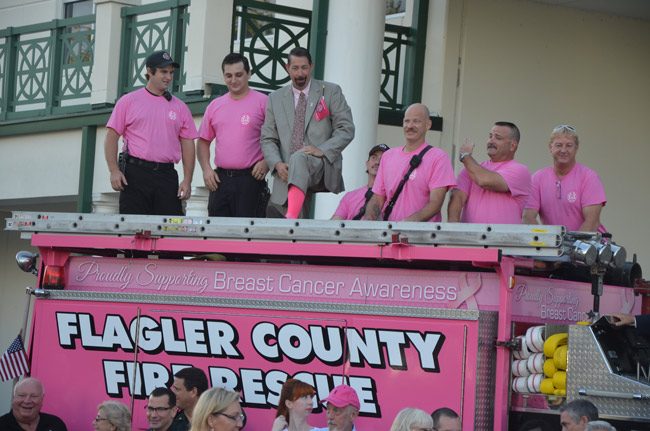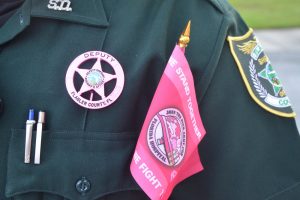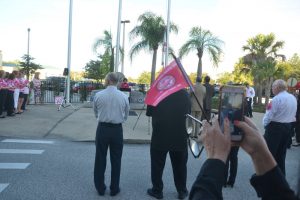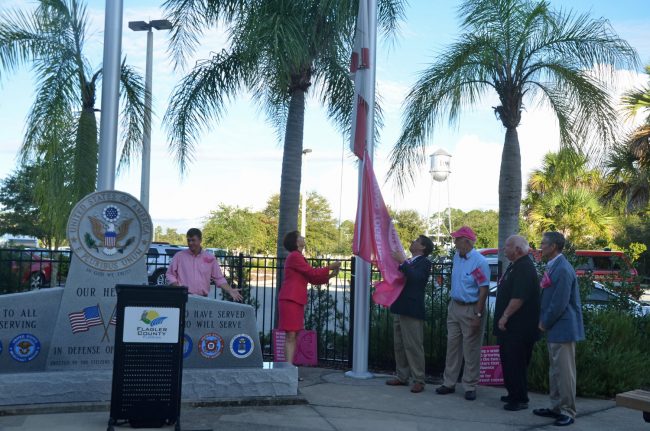
Like polio, like the plague, like tuberculosis, the measles and smallpox, there’ll be a time when breast cancer—if not every cancer—is vanquished. That’s no consolation for the 40,000 women who have died or will die of the disease this year alone in the United States, the 300,000 women who’ll be diagnosed with breast cancer this year, or the one in eight women who will be diagnosed sometime in their lifetime.
“Just look around this crowd and think about one in eight. That’s pretty scary if it hasn’t already affected you,” said Barbara Revels, who chairs the county commission and who spoke this morning to a small assembly of government workers and officials from Florida Hospital Flagler. They’d gathered in front of the Government Services Building in Bunnell, as they have every year in early October for the past half dozen years, to raise the Pink Army flag, the hospital’s coat of arms for its annual breast-cancer awareness and fund-raising campaign.
No one in the crowd of about 50 could possibly have been untouched, directly or through friends and family, by the epidemic, whose factual colors are nowhere near pink on its predatory spectrum: more than 2.8 million women have had a history of the disease. The numbers are slightly higher when men, who have a one-in-1,000 chance of developing the disease, are included, and higher by the grimmest factors when other cancers are included.

It’s why the pink-army flag-raising always combines the afterthoughts of a wake with the festive willfulness of hope, and of course a lot more than hope when awareness translates to early detection, and early detection usually means a life saved: the survival rate skyrockets when the disease is caught early. Much of the money the pink army campaign raises is devoted to underwriting mammograms, or clinical breast exams, for those who can’t afford them.
“And I know that through our hospital partners as well as the team of members that we have here in government,” Revels said, “all the great things that Suzanne Johnston’s done with her high teas and a variety of other resources that we tap, we hope we can put an end to breast cancer in both men and women.” Johnston, the Flagler County tax collector, was in the crowd, as pink from head to toe as the Flagler County firetruck was pink from bumper to bumper. County rescuers, often joined by their municipal counterparts, always find ways to mark October’s pinkness, wearing pink shirts or other attire. This year the department coated an entire fire truck in pink, thanks to Beachhouse Graphics, a company than layers vehicles in a removable application that looks indistinguishable from a paint job.
“We’re going to every event around the county to raise awareness,” Flagler County Fire Chief Don Petito said, pointing to the truck. Palm Coast Mayor Jon Netts, who’s always been part of the flag-raisings, was leaning on the truck’s front bumper—the first time he’s ever been seen leaning on Flagler County Fire Rescue.

The badge fund-raising was the work of sheriff’s employees Lauren Bennett and Sr. Cmdr. Steve
Cole. Some 160 employees participated, buying 127 badges and 41 civilian shirts, each making a $10 donation. (No public funds were used for this effort.) The sheriff’s own Laura Williams, a public information officer there (and at the flag-raising this morning), was grateful for her colleagues’ compassion. “I’m very touched by everyone’s generosity,” Williams said in a release issued this afternoon about the donation. “This continues to be a threat, despite amazing medical advances being made.”
There was a visual but unspoken gap in today’s flag-raising, as Flagler County’s commissioners lined up for the ceremony or for pictures, or as they stood near each other while one of them spoke: they were four, not five. They were missing Frank Meeker, at whose last flag-raising last year he’d appeared nearly hairless from the effects of chemotherapy. His was colon cancer, which claimed him by July. His absence was a silent reminder of cancer’s broader carnage and the enormity of the challenge to vanquish it in a nation that federally still can’t bring itself to spend more than $5 billion a year on cancer research–considerably less than the cost of a single aircraft carrier.
The big event for the Pink Army is the 5-K run and walk in Town Center on Oct. 16, which typically draws close to 1,000 people of all ages. The 2015 events netted the campaign $12,600, or $2,000 more than the previous year.
![]()






























Pinked Out says
‘Pink Army’ organization flags flown over government buildings, being given similar importance to the national, state, and POW/MIA flags? Men being forced to wear hot pink? I have empathy for breast cancer patients but this is getting silly, folks. Flagler seems to care less about Halloween with this pink stuff.
Algernon says
A worthy and heartwarming event. Thanks for covering it FlaglerLive.
Tealbutterfly12 says
There are other cancers out there that deserve attention, too. Time for the annual “pinkwashing” of the month of October.